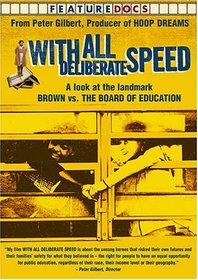| Actors: Vernon Jordan, Thurgood Marshall Jr., Barbara Johns, Julian Bond, Reverend Joe Delaine Director: Peter Gilbert Creators: Adam Singer, Andrew Lemon, Joe Arcidiacono, Peter Gilbert, Richard Oakes, Billy Campbell, Bruce Kennedy, Don Baer, Steve Carlis, Steve Rosenbaum, Nathan Antila Genres: Documentary, African American Cinema Sub-Genres: Biography, African American Cinema Studio: Starz / Anchor Bay Format: DVD - Color,Full Screen DVD Release Date: 01/25/2005 Original Release Date: 05/14/2004 Theatrical Release Date: 05/14/2004 Release Year: 2005 Run Time: 1hr 51min Screens: Color,Full Screen Number of Discs: 1 SwapaDVD Credits: 1 Total Copies: 0 Members Wishing: 0 MPAA Rating: Unrated Languages: English |
Search - With All Deliberate Speed on DVD
  | With All Deliberate Speed Actors: Vernon Jordan, Thurgood Marshall Jr., Barbara Johns, Julian Bond, Reverend Joe Delaine Director: Peter Gilbert Genres: Documentary, African American Cinema UR 2005 1hr 51min History ignored is history repeated. On May 17, 1954, the U.S. Supreme Court ruled in the case of Brown Vs. Board of Education that the concept of "separate but equal" school segregation was unconstitutional. But i... more » |
Larger Image |
Movie DetailsSimilar Movies
Similarly Requested DVDs
|
Movie ReviewsShould be shown in classrooms Ted Weimann | Vancouver, WA USA | 08/04/2007 (4 out of 5 stars) "This is the only documentary I have ever seen on the historic Brown vs. education decision. As an educator, I think it should be shown in contemporary high school classrooms to help our students understand that it wasn't that long ago that racial prejudice was institutuionalized in this country, and what a struggle it was to even start to bring about change. This video is a little on the long side, but can be watched over several class periods. An excellent discussion started and educational tool for the high school classroom. Teachers of history, psychology, street law, and civics classes should seriously consider making this a part of their curiculum." The Civil War isn't over. Timothy P. Scanlon | Hyattsville, MDUSA | 02/02/2008 (5 out of 5 stars) "In 1896, the Supreme Court ruled that "seperate but equal" was a legal doctrine, with a sole dissenting vote, the first John Marshall Harlan. In 1954, NAACP attorney, and later the first black Supreme Court justice Thurgood Marshall argued--and won--that it is NOT legal, in the milestone "Brown v. Board of Education" decision. The title of this film is the phrase which gave the states "adequate" time to integrate--or desegregate--their school systems.
I was impressed with the film for a couple of primary reasons: (1) We are accustomed to celebrity knowledge. Anyone remotely aware of civil rights know of King, or Malcolm X, of Medgar Evers. But there were and are others--many others--working in the dark before those figures even became celebrities. (And we know little, if anything, of them!) (2) Desegretation wasn't just a movement pushed by black people, but blacks and whites has to work TOGETHER. And they did, hence the laws going the way they did. The important theme of the film is that, despite Brown v. Board, there were two counties, one in South Carolina and the other in Virginia, who resisted the law using the phrase that makes up the film's title. One went so far as to close the school system for some time, lest they have to permit black people into white classrooms! I thought the film put together the history of these events appropriately. They fit into contexts, for example, and the film included those contexts. For instance, our school history/fairy tales indicate that slavery/racism was at least deinstitutionalized after the Civil War. Not so. As many an activist points out in the story, much of the South was using any technique they could to continue the caste system by which black people were "inferior," maintained that way by inferior schools. I thought the producers did a fine job too of describing how astute Marshall was in arguing Brown, and that, had the prior Chief Justice, someone of a contrarian, had not passed away and been replaced by Earl Warren, Brown might not have gone the way it did, and our country would be a different--and less desirable--place. Oh, another reason I liked the film is that many of the activists, most of them black, in the film, acknowledged that the world IS a better place regarding race relations that it was a half century ago. Frankly, I get tired out by young activists--black and white--who contend that nothing has changed. Is there work to do? Always. But it does no good to suggest that nothing has changed, that we're in a despair-filled pit of racial bigotry and we always will be. Let's get real. I recommend this film, to schools, to activists, maybe especially to those who contend nothing has changed over the years. And remember, there ARE people who worked on civil rights of whom you've never heard. It's about time we pay our respects to them, those who are living and those who are not. (I wish I could list some of their names here, but I'm never that complete in taking notes on a film!)" |
















